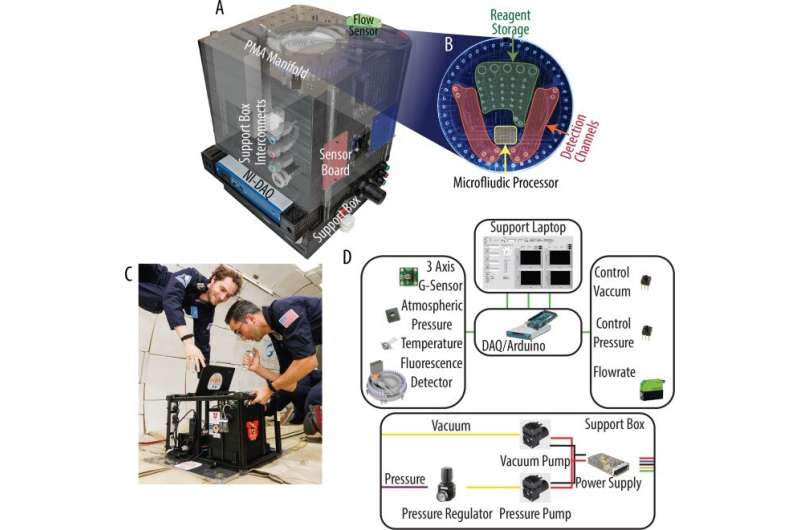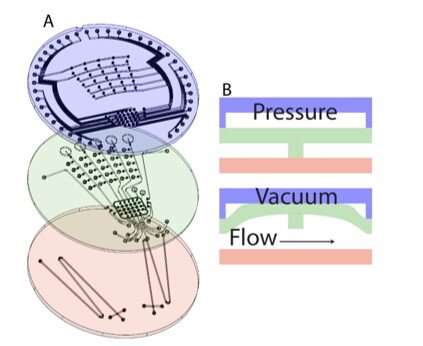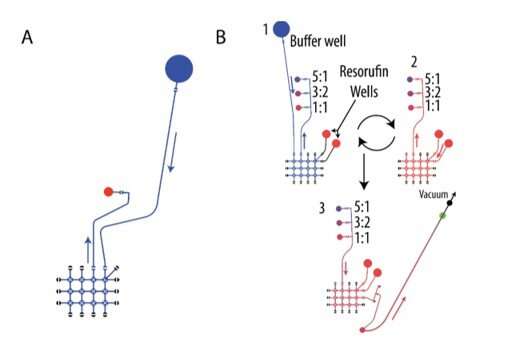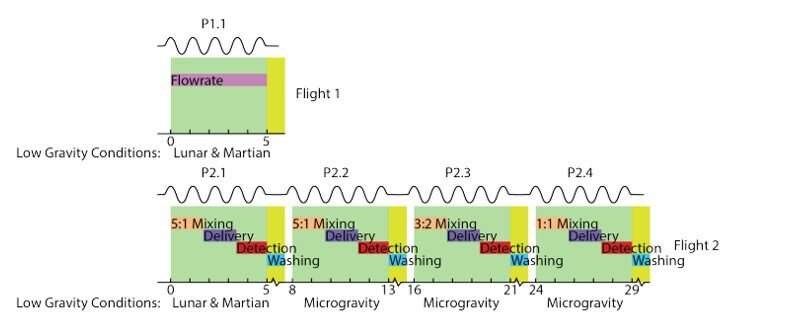June 15, 2023 feature
This article has been reviewed according to Science X's editorial process and policies. Editors have highlighted the following attributes while ensuring the content's credibility:
fact-checked
peer-reviewed publication
trusted source
proofread
Microfluidics in space to detect extraterrestrial life signatures and monitor astronaut health

In a new report now published in npj Microgravity, Zachary Estlack and a research team in mechanical engineering and space sciences at the University of Utah and the University of California, Berkeley, developed a microfluidic organic analyzer to detect life signatures beyond Earth and to clinically monitor astronaut health. The team performed extensive environmental tests across diverse gravitational atmospheres to confirm the functionality of the analyzer and its level of technology readiness.
The planetary scientists simulated environments of lunar, Martian, zero and hypergravity conditions typically encountered during a parabolic flight to confirm the functionality of the microfluidic analyzer. The study outcomes pave the way to integrate microfluidic instruments in a range of space mission opportunities.
Microfluidics in space
Microfluidics present a major technical innovation for in vitro biomedical research. The concept is also suited in astrobiology for spaceflight analyses of biological signatures by regulating fluid volumes at the nano-/micro-scale across highly sensitive biochemical investigations, while maintaining a minor physical footprint. As a result, the miniature instruments are specifically appealing to analyze biological imprints of extraterrestrial life.
Planetary scientists have already gathered and studied ice samples in depth from Saturn and Jupiter's moons Enceladus and Europa with microfluidic devices. Such analytical instruments are also useful to monitor flight crew health. Although the microfluidic bioanalysis systems are still in development, bioengineers aim to improve their gravitational sensitivity and power-efficiency for reconfigurable and compact in-situ space exploration.
Device configuration
Estlack and colleagues developed a microfluidic organic analyzer system (MOA) with an integrated programmable microwave array (PMA) alongside glass microchannels and a laser-induced fluorescence (LIF) detection system. During the development of the organic analyzer, they focused on a Technology Readiness level flight format instrument system to assess the maturity of the device for commercialization, as appropriate for space-flight, to identify the analytes of interest.
This work sheds light on the results of the first two flights in a series of five microgravity flights, to assess the performance of microfluidics under microgravity. The microfluidic valve arrays assisted the preparation and regulation of samples within the instrument, to automatically label, incubate and deliver samples to an integrated capillary electrophoresis chip and detect laser-induced fluorescence within the same setup. In total, the instrument integrated a microfluidic organic analyzer, a microvalve analyzer array containing an integrated chip for laser-induced fluorescence detection, and a sensor suite.
Testing the device under simulated parabolic flights
The research team studied the general functional parameters during the flight to ensure all testing environments were monitored and regulated. As the plane simulation climbed, the pressure dropped and resulted in an overall drop in temperature, which influenced the microfluidic instrument. The changes in operational parameters, however, had minimal impact on the overall performance of the instrument.
Estlack and the team conducted flow rate analyses during lunar, Martian and hypergravity periods of the flight. They noted changes to the initial back flow and peak flow rate with increased gravity. The outcomes of the simulations showed that the gravitational environment had minimal input on the performance of the instrument.
Rating the instruments performance
Based on the capacity for precise volume control under a variety of gravitational conditions, the team conducted automated dilutions to determine the instruments' performance for future biomarker array testing. They completed three stages of the dilution sequence and recorded them during flight.
During the first two stages, they transferred a buffer and a fluorophore to a storage well in desired ratios. During the final stage, they loaded a microvolume of the diluted fluorophore into built-in detection channels and transferred it past the fluorescence detector via vacuum. The experiments performed under microgravity or Martian gravity corresponded to a specific dilution sequence and showed little variation.
Enhancing the Technology Readiness level on the instruments
The space scientists and bioengineers integrated the results from the first two flights to improve the Technology Readiness of the microfluidic organic analyzer. Their successful performance under microgravity justified their inclusion in spaceflight missions. For instance, with decreasing gravity, the pumping performance of the instrument remained constant, although increased gravity impaired the instrument in the microvalve array region, nevertheless, the organic analyzer remained unaffected throughout varying conditions.
The study outcomes highlighted the suitability of the instrument for applications that detect and determine extraterrestrial chemical and biochemical analytes. The insensitivity of the instrument towards a gravitational field under simulated conditions in the lab justified its suitability for space deployment.
-

PMA-µCE chip assembly. (A) Exploded view of the layers of the PMAµCE chip (fluidic layer (green), the pneumatic layer (blue) and µCE chip (red)). The top and middle layers are fabricated using PDMS and conventional soft lithography, and the bottom layer is glass and fabricated with glass etching and bonding. The top layer is 4.5mm thick with 80 µm thick pneumatic channels that direct the applied pressure or vacuum to the desired microvalve. The middle layer is 250 µm thick with 50 µm high and 250 µm wide fluidic channels with the microvalve membranes and gates. These react to the pressure or vacuum states to open or close each microvalve on the chip. The fluidic channels are 250 µm wide to limit the impact of fluidic resistance and allow for faster operation. The bottom layer is a µCE chip that is used as a detection channel in these experiments. The µCE channel is 30 µm high and 110 µm wide. The three layers are integrated through oxygen plasma exposure bonding, with precise alignment ensuring the correct interfacing of the three layers. (B) The cross section of the fluidic layer (green) and how it interacts with the pneumatic layer (blue) and µCE chip (red) during both pressure and vacuum. The PMA can produce up to 850 nL per cycle of net forward flow under normal use and conditions with this simple pumping setup. Credit: npj Microgravity (2023). DOI: 10.1038/s41526-023-00290-3 -

Flow paths for each of the experiments performed during the microgravity flight. (A) The sequence used during the flowrate experiment, pulling from one storage well and pumping to another that is connected to the flowrate sensor. (B) Sequence used to test different mixing ratios, split into the three main components: buffer delivery, resorufin delivery, and loading and detection of diluted sample. Credit: npj Microgravity (2023). DOI: 10.1038/s41526-023-00290-3 -

Schedule of in-flight testing. The green regions designate periods of alternating low gravity and hyper gravity. Yellow is a period (~3 min) of level flight in between periods of low gravity parabolas. The line at the top of each flight designates a rough flight profile and the gravitational conditions are designated at the bottom. (Top) Flight 1 consisted of flowrate testing under Lunar & Martian gravity only as a mechanical issue with the aircraft forced the flight to end early. This allowed for changes to the experimental plan for the repeat flight. (Bottom) Flight 2 focused on mixing characterization, the chip sequentially mixed, delivered, and detected the designated mixtures of borate buffer and resorufin. In between P2.1 and P2.2 and after P2.4 the mixture volume remaining in the respective storage wells was removed for subsequent ground measurement verification. Credit: npj Microgravity (2023). DOI: 10.1038/s41526-023-00290-3
Outlook
In this way, Zachary Estlack and colleagues studied the technology readiness level of a microfluidic instrument for space missions to explore extraterrestrial biochemical signatures and monitor astronaut health in the future. The lessons learned from this first flight will impact future planned analyses under microgravity and hypergravity, which include investigations of capillary electrophoresis and astronaut crew health monitoring via simulated clinical assays to reveal biomarkers of specific interest.
The outcomes of these studies and the planned future flights will reveal the diverse capacity of the instruments during and after completing the planned space missions.
More information: Estlack et al, Operation of a programmable microfluidic organic analyzer under microgravity conditions simulating space flight environments, npj Microgravity (2023). DOI: 10.1038/s41526-023-00290-3
Alison M. Skelley et al, Development and evaluation of a microdevice for amino acid biomarker detection and analysis on Mars, Proceedings of the National Academy of Sciences (2005). DOI: 10.1073/pnas.0406798102
Journal information: Proceedings of the National Academy of Sciences
© 2023 Science X Network




















